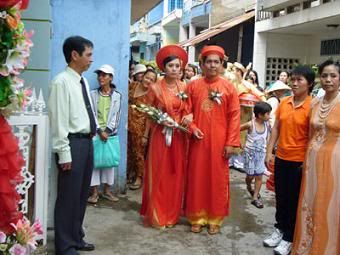
Temasek Polytechinic 2010
Vietnam on the move by Lady Borton
Vietnam Today: A Guide to a Nation at a Crossroads by Mark A. Ashwill
National Geographic Traveller: Vietnam by James Sullivan
1.Family

Every person has his or her place within the family, the village and the larger society. One's place determines his or her responsibilities, duties and privileges. Traditionally,the emphasis for men is strength, good behaviour and bread-winning capabilities while women were expected to show respect to men and elderly family memebers. The female did not have the right to join in any discussion and decision making. However, when Ho Chi Minh issued the Declaration of Independence in 1945, it brought about a drastic change to Vietnamese families. Women now have the right to work and housework responsibilities are shared equally among men and women. Children are of course taught to respect their parents and for siblings, it is the eldest son that is deemed as most important due to his role in passing down the family line
2.Values
The concept of face: "face" refers to how others think or say about you. In Vietnam, saving face is highly valued as a way of maintaining respect and harmony in interpersonal relationships.
The concept of suffering and misfortune: Vietnamese people are accustomed to hardship for both historical and geographical reasons. Many Vietnamese believe that they do not control their lives as their lives are dictated by fate and the action of others. However, this concept is starting to change as more and more young people try to study hard and improve their lives.
Attitude toward age: Age is highly valued in the society. Their view is that the older people deserve respect due to their experience, knowledge and wisdom. This attitude is changing as well as young people are seen as more dynamic and have an ability to learn faster, which are key factors in work life.
Filial Piety: Children are taught to be thankful to their parents for the debt of birth, their upbringing and education. This means that children are to put their family and parents first, above themselves. They are to make sacrifices for their parents and care for them in their old age. A Vietnamese person who neglects this responsibility is ostracised by the family and the society.
TRADITIONS
1. Marriage

In the olden days, marriage was often settled by family elders. Young people had no say over their choice of mates. However, now, young people meet and fall in love easily, and the parental role is reduced to offering advice. In rural areas, girls still marry in their late teens and boys in their early twenties but in the cities, the marriage age is becoming later as these city youths seek a good education and career first.
Traditionally, the groom's family will bring many gifts wrapped in red paper to the bride's house. The bride, normally dressed in a red ao dai( Vietnamese national dress) and the groom will kneel before the family altar to seek permission for the marriage from the ancestors. After various speeches, rings will be exchanged and parents will bless the newlywed with gifts of gold and jewellery.
Today, many Vietnamese couples exchange vows in churches or temples, but is still preceded by the traditional ceremony in the bride's home. A wedding banquet for those who can afford will be held to thank guests.
2. Funerals
In the past, caskets were often bought ahead of time and even sued as a bench at home. In towns and cities, this practice has been abandoned. The body also used to be kept in the home for as long as 6 months, but now it is kept for less than a week
The family will go through a mourning period of 100 days. During this period, Vietnamese try to abstain from entertainment as well as colourful clothing. They also gather befoire a specially erected altar and make offerings to the deceased. Musicians will also be hired to facilitate the funeral ritual. After the funeral, the altar that is already set up will be kept lighted with candles and incense sticks that are burned for a 100 days.
3. Festivals
Vietnamese Lunar New year:

Otherwise known as Tet, the Lunar New Year is a family oriented celebration. It is an occasion for each household to light up incense in remembrance of late relatives and also to welcome the first New Year visitors to their home. Some families set up a Tet tree in the week before New Year's eve. The tree, which is a bamboo pole stripped of most of its leaves except for a bunch at the top, is said to attract good spirits and repel bad ones. Traditionally, the Vietnamese celebrate Tet from the 15th of the twelth month to the 15th of the first month.
Trung Nguyen Festival: Celebrated by every family and pagoda, this festival's main objective is to "forgive the lost souls". Plain guel, votive papers and poopcorns are offered to "criminals released from hell"on the day itself.
Ooc-Om-Bok Festival: This festival is a religious service that worships the Moon Diety of the Khmer people. It is usually held when the dry seasons begin where the people pray for good weather, good luck, happiness and bumper crops. The adults will make sticky rice while children sing, dance and play around.
Mid- Autum Festival: Every year on the 15th day of the 8th month, children throughout vietnam march in a procession, carrying their lanterns. They also get to eat mooncakes and perform the dragon dance. The adults will gather in small groups to sing songs and recite poetry. It is also a time of gift exchange and blessings.
Labels: Culture and traditions